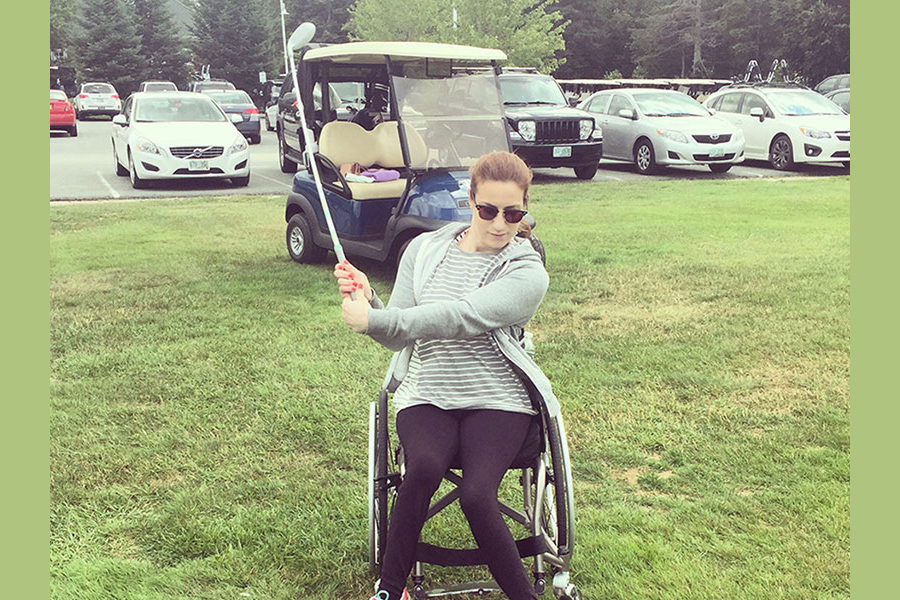The Jetson age is upon us…
Global communication is happening at the speed of thought, across many different platforms with no signs of slowing down. Computer hardware and software continues to get smaller and faster, with the latest voice activation and hands-free tech integrating into our homes and automobiles. Our electronics are becoming an extension of our body and mind, ubiquitous with society, changing the way we interact and manage our lives. In my opinion, if you are going to live with a spinal cord injury, faced with physical challenges around every corner, there has been no better time in history than now!
Computers & Phones
Paralysis from a spinal cord injury can make the simple task of using a computer, phone or writing very difficult. Today, our world has technology that can empower a user at school, work, home and play. This technology can transform a persons ability to access global information, connect via social networking, and provide the ability to manage a home or work environment independently via voice command.
The personal tablet, the smart phone and even the smart watch put the power of information at one’s fingertips. Their portability makes them ideal for people with mobility issues. Add in high-tech voice-recognition and other hands-free technologies, such as adaptive keyboards, head-tracking mouse clickers, screen readers and screen-enlargement applications, one can become the master of their digital universe. High level quadriplegics and/or people with upper-body limitations can operate these devices and navigate the Internet using voice, breath, eye, or head movements. There are even emerging technologies like brain-machine interfaces, which read nerve signals from the brain and translate them into commands on a device … but that’s next level, and another conversation.
To access this technology, the traditional process goes like this: A therapist will evaluate you to determine which adaptive equipment may help you. If you need a speech-generating device or other augmentative communication device, a speech-language pathologist will evaluate and recommend the most appropriate options that your insurance plan will cover.
If you are anything like me, I like to enhance and expedite the process by asking my therapists a lot of techie questions, doing my own research, and then finding the coolest stuff for myself!
The array of assistive devices for computing and communicating is vast, and changing rapidly. That means that today’s latest and greatest may be obsolete and gone tomorrow. Listed below are a few of the primary phone and computer technologies that are commercially available:
COMPUTER, PHONE & TABLET RESOURCES:
- PHONE:
- Apple – iPhone X, 8/8 Plus
- Samsung – Galaxy Note 8
- Google – Pixel 2XL & Pixel 2
- LG – V30
- COMPUTERS & TABLETS:
- Apple – iMac, MacBook, iPad
- Dell – Inspiron / XPS Desktop & Laptop
- HP – Pavilion, Envy, Spectre
- Microsoft – Surface Studio
- The Reeve Foundation has a Fact Sheet on Assistive Technology – Computers. This includes a list of manufacturers and resources for assisted computing and communicating: ChristopherReeve.org/Factsheets and search for “assistive technology computers” under Topic Resources
- RJ Cooper & Associates offers dozens of assistive technology solutions, including custom adaptations for the iPad: rjcooper.com
- AbleNet offers a range of assistive technology, curriculums, and services to help individuals with disabilities lead productive and fulfilling lives: ablenetinc.com
- Makoa has a comprehensive listing of products, services, and resources to make computing accessible to people with disabilities: www.makoa.org/computers.htm
- The Accessibility Clearinghouse is an information hub from the Federal Communications Commission (FCC) about phones and innovative ways to communicate, especially for people who may have a disability: https://www.fcc.gov/general/accessibility-clearinghouse-0
VOICE-RECOGNITION SYSTEMS: (Source: www.makoa.org)
- Discrete Speech
- Nuance DragonDictate
- E-Speaking Free voice command and control program for Windows computers
- Tazti speech recognition Free speech recognition software – free download
- Continuous Speech
- Nuance Dragon Naturally Speaking
- Synapse AP Universal and UNIX voice recognition
EYE-GAZE TECHNOLOGY: (Source: www.makoa.org)
- DynaVox Mayer-Johnson
- LC Technologies, Inc Eyegaze Communication Systems
- VisionKey Computer Controller Eye control input
- Tobii Eye Control Systems Tobii PCEye and CEye and Eye Trackers for PC Gaming
MOUSE ALTERNATIVES & POINTING DEVICES (Source: www.makoa.org)
- Cirque GlidePoint touchpad controllers
- CameraMouse hands-free mouse gives computer control without headgear
- Logitech Trackballs
- NaturalPoint trackIR control of your computer by tracking your body motion
- Nohands Mouse foot-controlled mouse
- Origin Instruments HeadMouse Head-Controlled Pointing Systems
- PI Engineering X-keys Switch Interface; Ymouse – attach 2 mice to 1 port
- Prentke Romich Company HeadMaster, Jouse
- RJ Cooper’s Special Needs Switch-Adapted Mouse devices
- SEMCO QuadJoy mouse for Quadriplegic
- TetraMouse alternative computer mouse for people who cannot use their hands
Control Your Environment
Voice-activated environmental control (EC) is everywhere: just ask Siri or Alexa which lights you want to turn on or off, what music station to play, which channel to surf or what temperature to set in your home, office or car. Spinal cord injury or not, we as a species are moving closer and closer to autonomous artificial intelligence. Amazing. And scary.
And although paralysis often restricts one’s ability to control day-to-day environmental comfort, an environmental control unit (ECU) can empower a person’s life, their functional ability, independence, and safety in many different settings.
An ECU is basically an advanced remote control system for electronic devices, turning a house into a smart home. It enables a person to independently turn on or off any electronics such as lights, heat, air conditioning, stereo, or television; to answer or initiate phone calls; to unlock doors; and to open and close windows or window shades. Essentially any aspect of the environment can be controlled depending upon the system’s complexity.
In addition to the new generation of voice-activated digital assistants, the traditional user interface might be an array of hardwired switches at a doorway, a remote-control joystick mounted on a wheelchair, or a touchscreen tablet with wireless Bluetooth technology, or by “sip and puff,” or even by detecting eye blinks, eye direction, or head movements. Incredible!
The key is to find the right system for your needs and an installer who will work to customize it. I suggest plenty of research and test drives before investing. Below are a few resources to get you started:
ECU RESOURCES:
- Amazon – Echo, Echo Dot, and portable Echo Tap
- Google – Nest
- Apple – HomeKit
- The Reeve Foundation’s Fact Sheet on Assistive Technology – Environmental Controls includes a list of manufacturers of ECUs, as well as general information and funding services: ChristopherReeve.org/Factsheets and search for “assistive technology environmental controls” under Topic Resources
- Quartet Technology Incorporated (QTI) offers a high-end “Simplicity” line of ECU units that operate by voice, switches, or computer mouse: 978-957-4328 or www.qtiusa.com
- Home Automated Living (HAL) makes software that turns a laptop or tablet into an ECU controllable from anywhere: 855-442-5435 or automatedliving.com
However you plug yourself into the matrix to control your reality and to communicate with your family, friends, house or car: enjoy the sound of your voice, because mind-control is just around the corner!
Cheers,
Aaron
For more information, see related articles and resources here:









 I have c6 injury and I have lots of spasm in my whole body. What can you suggest to help?
I have c6 injury and I have lots of spasm in my whole body. What can you suggest to help?






